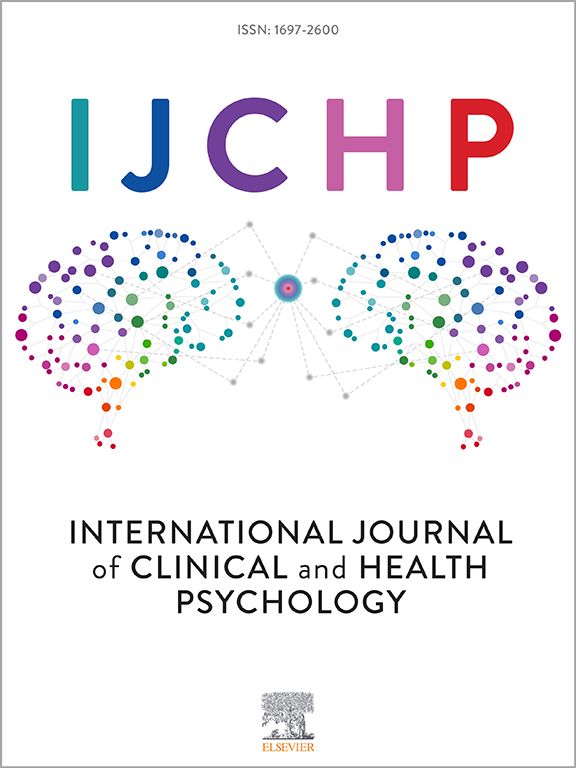改善你的情绪:运动和杏仁核如何一起跳舞
IF 4.4
1区 心理学
Q1 PSYCHOLOGY, CLINICAL
International Journal of Clinical and Health Psychology
Pub Date : 2025-07-01
DOI:10.1016/j.ijchp.2025.100610
引用次数: 0
摘要
越来越多的证据表明,杏仁核亚区存在功能异质性。最近,人们观察到运动作为一种自动情绪调节,可以诱导与情绪变化相关的杏仁核激活的改变。然而,杏仁核亚区在这些影响下的具体作用尚未完全了解。本研究采用静息状态功能磁共振成像(rs-fMRI)技术,探讨了杏仁核亚区在急性运动诱导的情绪改善中是否有不同的作用。招募年龄在18-22岁的参与者76人,随机分为运动组和对照组。运动组接受30分钟中等强度运动干预,对照组在静息状态下完成阅读控制任务。在干预前后进行全脑磁共振成像扫描。此外,参与者的情绪也被评估使用积极和消极情绪表(PANAS)和情绪状态简表。采用混合效应模型分析组×时间相互作用对各半球内侧杏仁核(mAmyg)和外侧杏仁核(lAmyg)亚区功能连接(FC)的影响。结果显示,运动诱导的情绪改善与组×时间对FC的交互作用显著相关,表现出显著的右半球优势。具体来说,右脑皮层与眶额皮质、顶叶和小脑区域的连通性增强与负面情绪的减少和自尊的增加有关。与此同时,右脑lAmyg与眶额叶皮层和纹状体的连接增强与广泛的改善有关,包括减少紧张和愤怒,增加活力。这些发现表明,剧烈运动通过以不同杏仁核亚区为中心的不同的、偏侧的神经通路改善情绪。mAmyg和lAmyg在自动情绪调节中发挥互补作用,正确的mAmyg调节情感效价和自我评价,而正确的lAmyg似乎调节广泛的情绪状态并增强积极唤醒。这项工作为运动的治疗效果提供了一个更细致的神经生物学模型。本文章由计算机程序翻译,如有差异,请以英文原文为准。
Boosting your mood: How exercise and the amygdala dance together
Accumulative evidence has shown that functional heterogeneity exists in subregions of amygdala. Recently, exercise serving as automatic emotion regulation has been observed to induce the altered activation of amygdala associated with mood change. However, the specific role of subregions of amygdala underlying these effects are not fully understood. By using resting-state functional magnetic resonance imaging (rs-fMRI), this study examined whether the subregions of amygdala play distinct roles in mood improvement induced by acute exercise.
Participants (n = 76) aged 18–22 were recruited and randomly divided into the exercise group and the control group. The exercise group received a 30-minute intervention with moderate-intensity exercise while the control group completed a reading control task at resting state. Whole-brain rs-fMRI scans were conducted before and after the interventions. Moreover, participants’ moods were also assessed using the Positive and Negative Affect Schedule (PANAS) and Abbreviated Profile of Mood States. A mixed-effect model was used to analyze the Group × Time interaction on functional connectivity (FC) seeded from medial amygdala (mAmyg) and lateral amygdala (lAmyg) subregions in each hemisphere.
Results revealed that exercise-induced mood improvements were correlated with significant Group × Time interaction effects on FC, showing a notable right-hemispheric predominance. Specifically, enhanced connectivity of the right mAmyg with orbitofrontal cortex, parietal, and cerebellar regions was associated with reduced negative affect and increased self-esteem. Concurrently, enhanced connectivity of the right lAmyg with the orbitofrontal cortex and striatum was linked to a broad spectrum of improvements, including reduced tension and anger, and increased vigor.
These findings suggest that acute exercise improves mood via distinct, lateralized neural pathways centered on different amygdala subregions. The mAmyg and lAmyg play complementary roles in automatic emotion regulation, with the right mAmyg modulating affective valence and self-evaluation, while the right lAmyg appears to regulate a broad spectrum of mood states and enhance positive arousal. This work provides a more nuanced neurobiological model for the therapeutic effects of exercise.
求助全文
通过发布文献求助,成功后即可免费获取论文全文。
去求助
来源期刊

International Journal of Clinical and Health Psychology
PSYCHOLOGY, CLINICAL-
CiteScore
10.70
自引率
5.70%
发文量
38
审稿时长
33 days
期刊介绍:
The International Journal of Clinical and Health Psychology is dedicated to publishing manuscripts with a strong emphasis on both basic and applied research, encompassing experimental, clinical, and theoretical contributions that advance the fields of Clinical and Health Psychology. With a focus on four core domains—clinical psychology and psychotherapy, psychopathology, health psychology, and clinical neurosciences—the IJCHP seeks to provide a comprehensive platform for scholarly discourse and innovation. The journal accepts Original Articles (empirical studies) and Review Articles. Manuscripts submitted to IJCHP should be original and not previously published or under consideration elsewhere. All signing authors must unanimously agree on the submitted version of the manuscript. By submitting their work, authors agree to transfer their copyrights to the Journal for the duration of the editorial process.
 求助内容:
求助内容: 应助结果提醒方式:
应助结果提醒方式:


